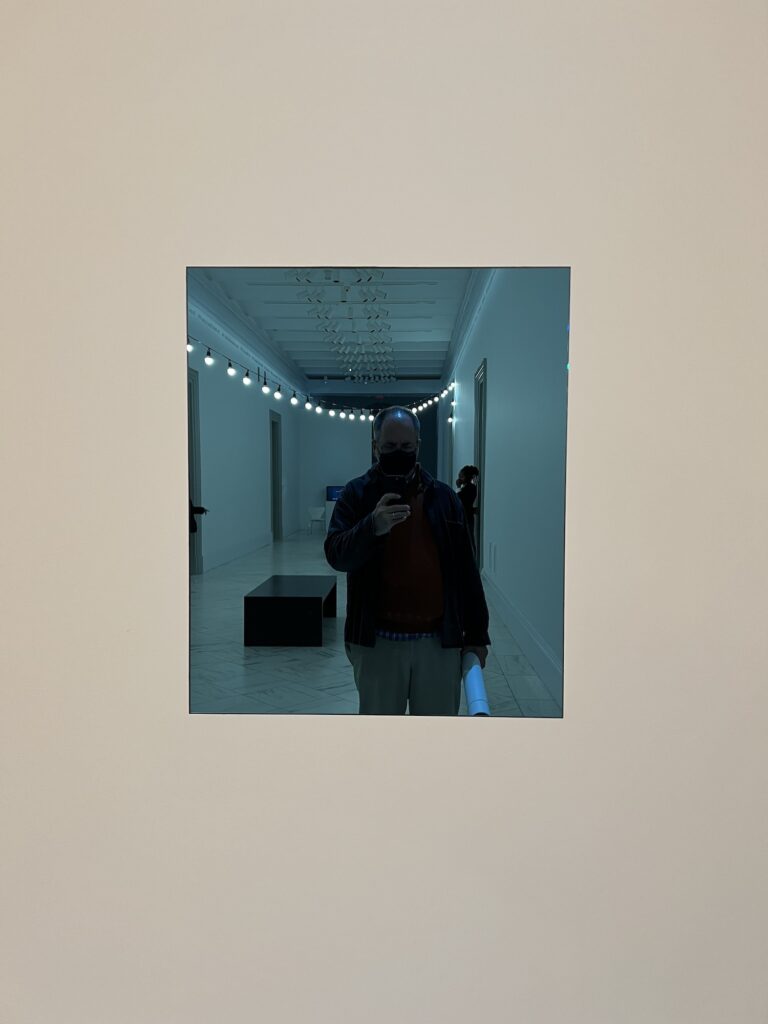
“If an owner has chosen to lend the work for an exhibition, the owner may choose to simultaneously install the work.”
“An authorized manifestation of [the work] is the work, and should be referred to only as the work.”
Via a recent post to Instagram by the Felix Gonzalez-Torres Foundation I learned what I could have realized many years ago: that “Untitled” (Fear), 1991, the blue-tinted mirror, is not an object, but a work. And as such, it can be presented in multiple manifestations simultaneously.
In fact, it has, and it is.
In 2016, “Untitled” (Fear) was included in three overlapping shows in four venues over the course of eight months, from May to December: at Hauser & Wirth in London (itself part of a simultaneous three-venue presentation, though I think this mirror was only in London); at PAC and ZAC in Milan and Palermo, respectively [Oprah shruggie dot gif]; and at Reading Prison in Reading (UK). As I type this, it is installed—or should I say manifested?—at the National Portrait Gallery in Washington, and at Anonymous Gallery in New York.
Through it all, and at least since the catalogue raisonné went to print in 1997, it has remained in the collection of Michele Brunelli, who has apparently been a busy and generous lender. The CR notes only that “The work is ideally presented embedded in wall.”
It is the simultaneous exhibitions in 2016 that were the first public indication that, like consumable works made of piles of candy or stacks of paper, the existence of “Untitled” (Fear) is not constrained to a single, unsigned, physical object.
And indeed, “Untitled” (Fear) is one of eleven individual works for which the Foundation is preparing tailored Core Tenets. Two other mirror-based works, “Untitled” (March 5th) #1 (1991), and “Untitled” (Orpheus, Twice) (1991), each have their own Core Tenets forthcoming, but so far, only the latter has been exhibited in more than one location simultaneously.
The Core Tenets Project is an ongoing research effort by the Foundation to provide “language around the nature and structure of the works,” and to explain their “specific, yet sometimes open-ended parameters.” Some of these parameters, presumably, are included in the artist’s certificates that accompany each work, but the Foundation’s clear point is also that these tenets and parameters can change as research progresses and language develops. The two quotes at the top of this post are from the current in-process version of Core Tenets document for “Untitled” (Sagitario) [pdf], the posthumously realized embedded double pool work exhibited at David Zwirner in 2019. They feel like the kind of parameters currently at work with “Untitled” (Fear).
It would be interesting to hear the experience of Michele Brunelli about how his engagement and stewardship of this work has changed as its parameters have evolved. Perhaps it was always the case that kept his original mirror on his wall whenever he loaned the work. Perhaps it broke when he moved, and he replaced it, no problem? Have Howard and Barbara Morse, the longtime collectors of “Untitled” (March 5th) #1, had a different experience keeping their two round mirrors at home while lending them consecutively?
I can also imagine a divergence of understanding as Felix works whose core tenets are being a unique, signed, physical object when their age or condition changes how they’re experienced, or constrains how or where they’re exhibited. But maybe these live alongside rub-on transfers and billboards that can’t be moved, and stacks of prints that can’t be taken, adding to the complexity of what and how Felix thought art could be.
